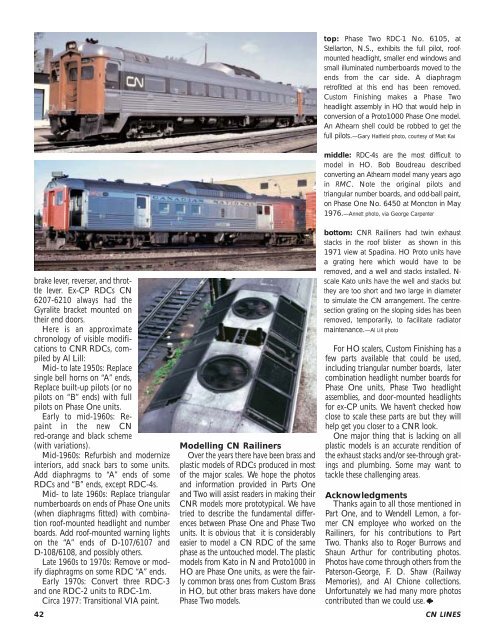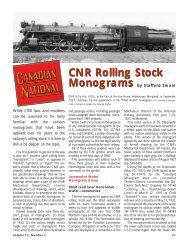CN LINES V12N3 - Canadian National Railways Historical Association
CN LINES V12N3 - Canadian National Railways Historical Association
CN LINES V12N3 - Canadian National Railways Historical Association
You also want an ePaper? Increase the reach of your titles
YUMPU automatically turns print PDFs into web optimized ePapers that Google loves.
ake lever, reverser, and throttle<br />
lever. Ex-CP RDCs <strong>CN</strong><br />
6207-6210 always had the<br />
Gyralite bracket mounted on<br />
their end doors.<br />
Here is an approximate<br />
chronology of visible modifications<br />
to <strong>CN</strong>R RDCs, compiled<br />
by Al Lill:<br />
Mid- to late 1950s: Replace<br />
single bell horns on “A” ends,<br />
Replace built-up pilots (or no<br />
pilots on “B” ends) with full<br />
pilots on Phase One units.<br />
Early to mid-1960s: Repaint<br />
in the new <strong>CN</strong><br />
red-orange and black scheme<br />
(with variations).<br />
Mid-1960s: Refurbish and modernize<br />
interiors, add snack bars to some units.<br />
Add diaphragms to “A” ends of some<br />
RDCs and “B” ends, except RDC-4s.<br />
Mid- to late 1960s: Replace triangular<br />
numberboards on ends of Phase One units<br />
(when diaphragms fitted) with combination<br />
roof-mounted headlight and number<br />
boards. Add roof-mounted warning lights<br />
on the “A” ends of D-107/6107 and<br />
D-108/6108, and possibly others.<br />
Late 1960s to 1970s: Remove or modify<br />
diaphragms on some RDC “A” ends.<br />
Early 1970s: Convert three RDC-3<br />
and one RDC-2 units to RDC-1m.<br />
Circa 1977: Transitional VIA paint.<br />
Modelling <strong>CN</strong> Railiners<br />
Over the years there have been brass and<br />
plastic models of RDCs produced in most<br />
of the major scales. We hope the photos<br />
and information provided in Parts One<br />
and Two will assist readers in making their<br />
<strong>CN</strong>R models more prototypical. We have<br />
tried to describe the fundamental differences<br />
between Phase One and Phase Two<br />
units. It is obvious that it is considerably<br />
easier to model a <strong>CN</strong> RDC of the same<br />
phase as the untouched model. The plastic<br />
models from Kato in N and Proto1000 in<br />
HO are Phase One units, as were the fairly<br />
common brass ones from Custom Brass<br />
in HO, but other brass makers have done<br />
Phase Two models.<br />
top: Phase Two RDC-1 No. 6105, at<br />
Stellarton, N.S., exhibits the full pilot, roofmounted<br />
headlight, smaller end windows and<br />
small illuminated numberboards moved to the<br />
ends from the car side. A diaphragm<br />
retrofitted at this end has been removed.<br />
Custom Finishing makes a Phase Two<br />
headlight assembly in HO that would help in<br />
conversion of a Proto1000 Phase One model.<br />
An Athearn shell could be robbed to get the<br />
full pilots.—Gary Hatfield photo, courtesy of Matt Kai<br />
middle: RDC-4s are the most difficult to<br />
model in HO. Bob Boudreau described<br />
converting an Athearn model many years ago<br />
in RMC. Note the original pilots and<br />
triangular number boards, and odd-ball paint,<br />
on Phase One No. 6450 at Moncton in May<br />
1976.—Annett photo, via George Carpenter<br />
bottom: <strong>CN</strong>R Railiners had twin exhaust<br />
stacks in the roof blister as shown in this<br />
1971 view at Spadina. HO Proto units have<br />
a grating here which would have to be<br />
removed, and a well and stacks installed. Nscale<br />
Kato units have the well and stacks but<br />
they are too short and two large in diameter<br />
to simulate the <strong>CN</strong> arrangement. The centresection<br />
grating on the sloping sides has been<br />
removed, temporarily, to facilitate radiator<br />
maintenance.—Al Lill photo<br />
For HO scalers, Custom Finishing has a<br />
few parts available that could be used,<br />
including triangular number boards, later<br />
combination headlight number boards for<br />
Phase One units, Phase Two headlight<br />
assemblies, and door-mounted headlights<br />
for ex-CP units. We haven’t checked how<br />
close to scale these parts are but they will<br />
help get you closer to a <strong>CN</strong>R look.<br />
One major thing that is lacking on all<br />
plastic models is an accurate rendition of<br />
the exhaust stacks and/or see-through gratings<br />
and plumbing. Some may want to<br />
tackle these challenging areas.<br />
Acknowledgments<br />
Thanks again to all those mentioned in<br />
Part One, and to Wendell Lemon, a former<br />
<strong>CN</strong> employee who worked on the<br />
Railiners, for his contributions to Part<br />
Two. Thanks also to Roger Burrows and<br />
Shaun Arthur for contributing photos.<br />
Photos have come through others from the<br />
Paterson-George, F. D. Shaw (Railway<br />
Memories), and Al Chione collections.<br />
Unfortunately we had many more photos<br />
contributed than we could use.<br />
42 <strong>CN</strong> <strong>LINES</strong>



